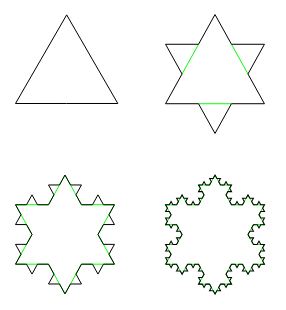Infinite Border, Finite Area
Koch's snowflake is a quintessential example of a fractal curve, a curve of infinite length in a bounded region of the plane. Not every bounded piece of the plane may be associated with a numerical value called area, but the region enclosed by the Koch's curve may. Let's see why.

We start with one triangle - a polygon or a broken line - whose boundary consists of three line segments. On each iteration, each line segment is divided into three parts and the middle part is replaced with two forming an equilateral triangle with the base removed. However, the area of these equilateral triangles is added to the area at the previous step. The areas thus accumulate and may be expected to reach a limit because the totals always remain in a bounded region.
This reasoning is sufficient for a claim of the existence of a curve of infinite length that encloses a finite area. In the particular example of Koch's curve it is not difficult to find an actual value of that area.
Recollect that the area of the equilateral triangle of side length a equals
The second iteration then adds 12 triangles of side length
As a result of the area accumulation we obtain the following series:
S = A + A × 3 × (1/3)2 + A × 3·4 × (1/3)4 + A × 3·42 × (1/3)6 + ...
Excluding the first term, we have a geometric series:
| S | = A (1 + 3/9 ∑n ≥ 0(4/9)n) | |
| = A (1 + 1/3 × 1 / (1 - 4/9)) | ||
| = A (1 + 1/3 × 9/5) | ||
| = A (1 + 3 /5) | ||
| = 8A / 5. |
We see that Koch's curve whose construction begins with a triangle of side 1 encloses the area of
... to be continued ...
- What Is Infinity?
- What Is Finite?
- Infinity As a Limit
- Cardinal Numbers
- Ordinal Numbers
- Surreal Numbers
- Infinitesimals. Non-standard Analysis
- Various Geometric Infinities
- Paradoxes of Infinity
|Contact| |Front page| |Contents| |Up| |Algebra|
Copyright © 1996-2018 Alexander Bogomolny71753251
